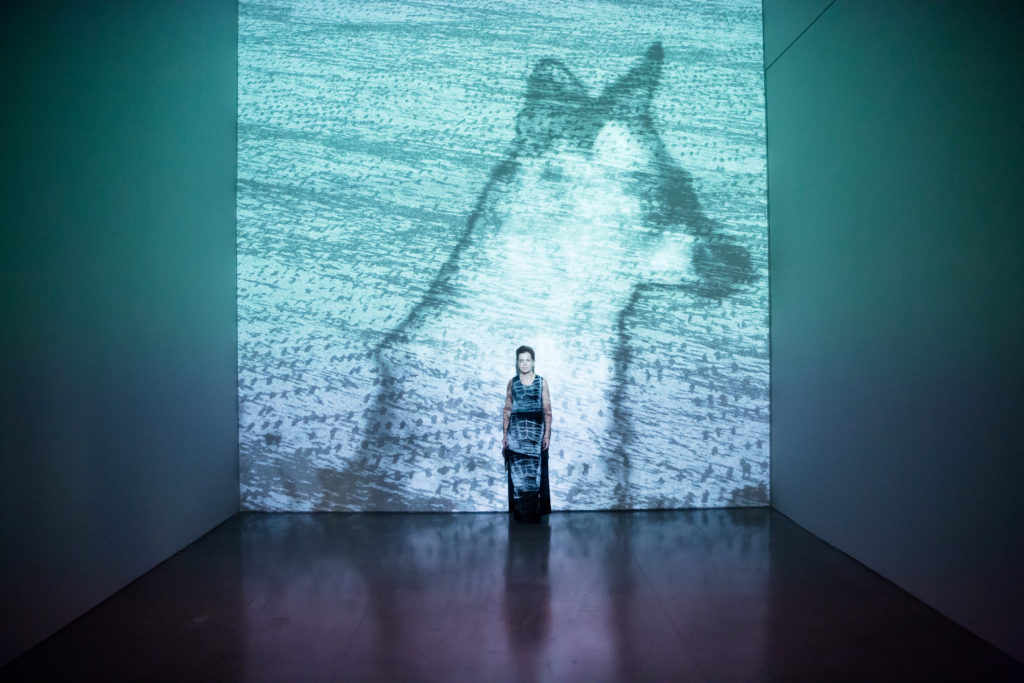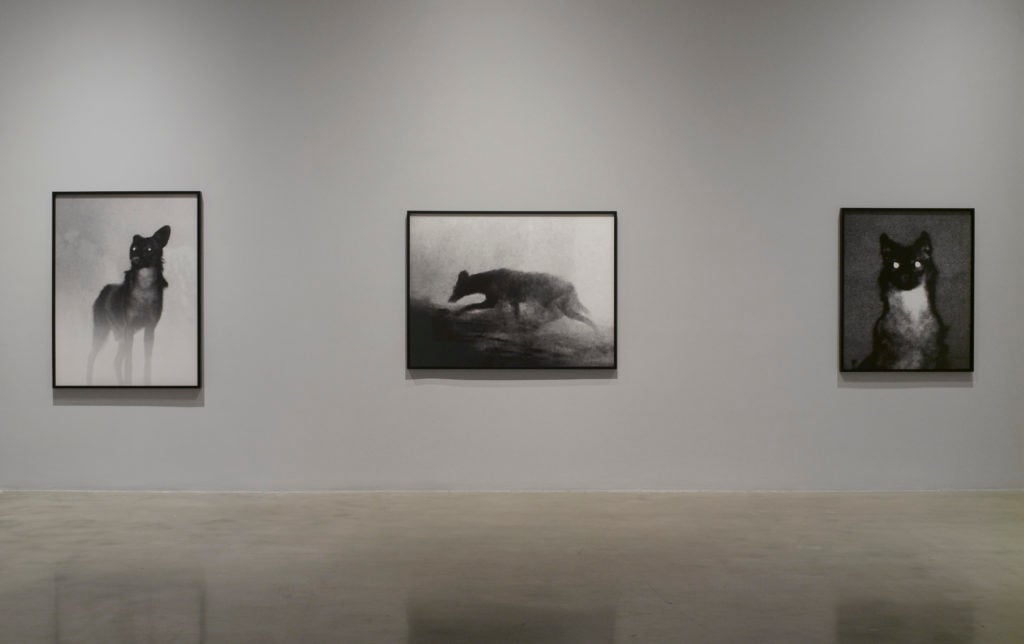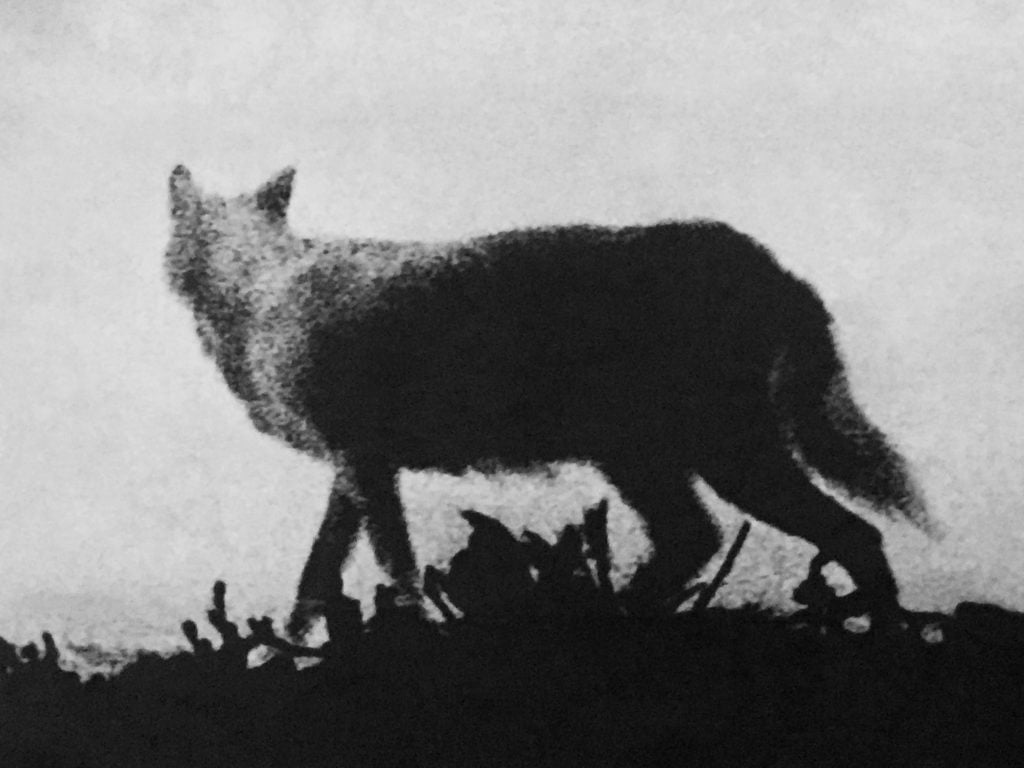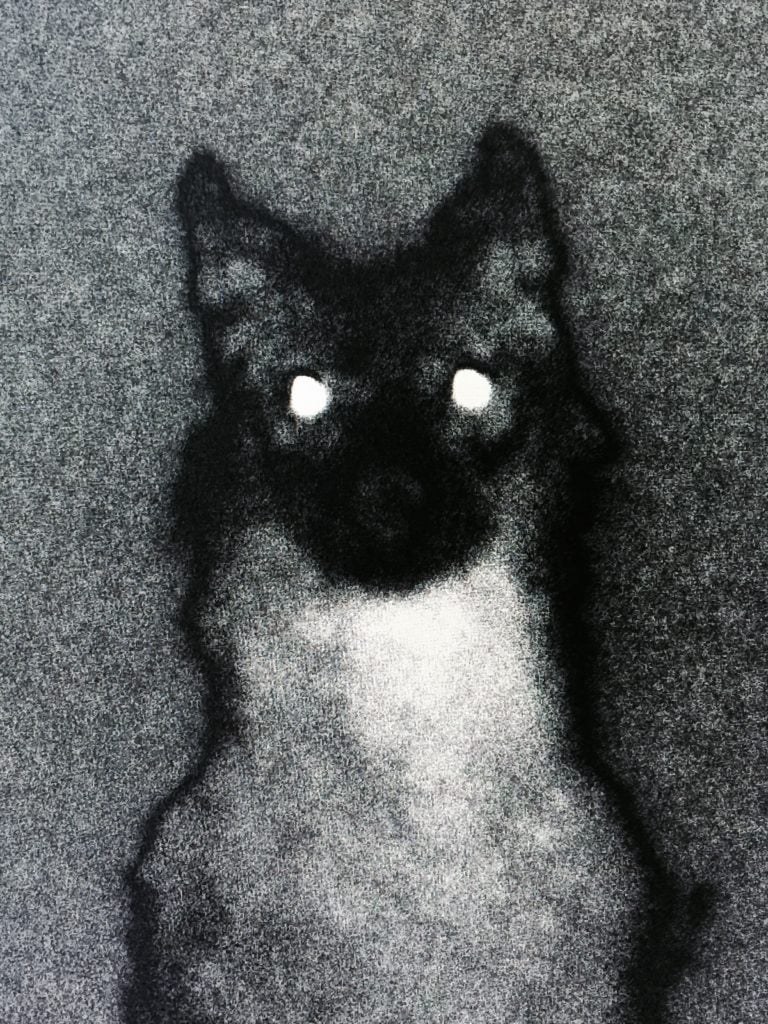Reviews
Michal Rovner’s Doormen of the Dark Side at Pace Gallery
The artist conjures a haunting night of the jackal.

The artist conjures a haunting night of the jackal.

Laura van Straaten

Less than 24 hours before the opening of her arresting exhibition at Pace Gallery in New York’s Chelsea, artist Michal Rovner swept into one of the galleries—where dozens of people were scurrying about and standing on ladders—gesticulating madly with tools in hand. Artworks were leaning here and there, with crates scattered about the floor. The artist carried a round platter with sweets and snacks from her native Israel: nuts, Halvah, two kinds of dates. “Hallo!” she called out. “Food!”
It’s awfully hard to conduct an interview and an exhibition tour when both parties have their mouths full of sticky dates and sweet sesame paste candy, but it’s just as well. That’s because Rovner prefers to let the work speak for itself. And what it—and she—has to say is all the stronger for that.
As she wrote in the catalogue for her 2011 solo exhibition at the Louvre, “[P]eople desire to have more information, my desire is to erase information.” She doesn’t like to “deal with information, details, data.”
The exhibition, on view at Pace through October 22, comprises four rooms of ghostly gray images of nocturnal jackals that the artist filmed using night vision photographic equipment, or, she said, the kind of technology used in security cameras (or, as she put it, to fight terrorists). Rovner compared the images to daguerreotypes, but they are grainier, grayer, and ghostlier—the eyes of each animal blankly white.

Installation view of Michal Rovner: Night. Pace Gallery. 510 West 25th Street, New York. September 16—October 22, 2016. Photo by: Kerry Ryan McFate / Pace Gallery.
The animals are haunting but in the way used to describe beauty rather than a horror film, even though jackals, of course, are long associated with not only the afterlife, or even with the post-apocalyptic: they tend to live on the periphery and among the ruins of human life. “The jackals will stay for sure long after we are gone,” she mused, with less gloom and more matter-of-factness than you’d imagine. When she pointed out that not a single image in the show has a foreground or background, I thought: she’s right, that’s what death looks like, no past or future—only the eternal present.
The work, all created this year, is wholly original, though the primordial shapes instantly called to mind the transparent quality of the animal drawings in the caves at Lascaux, as well as the shadowy, usually featureless horses and other animals in Susan Rothenberg’s paintings.
Rovner, who splits her time between Israel and New York and has had more than 60 solo exhibitions around the world, including a 2002 retrospective at the Whitney, spent “months and months” driving late at night to dark fields to lie in wait for the animals to appear. Terror was her constant companion. “It is very much about fear, the unknown, what you don’t know, what you don’t see,” she said. Marc Glimcher, who organzied the exhibition along with Samanthe Lobosco, described her as “trying to become part of the pack.” She added, “I realized after a while that I’m hearing better and I’m seeing better in the dark.” She recalled saying to herself, “Well, it was worth it to be an artist just to come to this moment.”
The exhibition is entitled Night, though she averred that this is not a tribute to Elie Wiesel, who died in July, nor to his book of the same name about his experiences during the Holocaust.

Michal Rovner, Night #9, 2016, archival pigment print 43-11/16” x 58-1/4” (111 cm x 148 cm). Edition 1 of 7. Photo courtesy Michal Rovner © Michal Rovner, courtesy Pace Gallery.
But jackals are more than just the doormen of the dark side. The species that Rovner captured on film are likely golden jackals. These animals—mentioned more than a dozen times in the Bible, Rovner pointed out—claim the Middle East and South Asia as their territory. And they are feature players in the folklore and literature of these regions, most often as tricksters (like the wily coyote or the clever fox in tales North America and Europe). In Europe, the golden jackal is considered a scavenger, a form of vermin whose presence signals a certain degradation of the place where it is found. I didn’t get a chance to ask Rovner about this, but it occurred to me these jackals are characterized in much the same way that anti-Semites have characterized Jewish people for eons. (Even Kafka used them in his much debated short parable “Jackals and Arabs.”)
The next gallery comprises images that appear to be intensely shaded pencil drawings on paper, almost pointillistic in parts. In fact, they are still images captured from video to which Rovner has applied several processes, about which she prefers to be vague. “In my work, I always start from reality, collecting or recording things from reality and then shifting them out of identity, location, specifics….” she wrote in the Louvre catalogue. Glimcher, however, revealed that one of her techniques is to project the video on the uneven surface of the walls of her Israel studio and then take photographic images with the second camera.
Two jackals in profile guard the door to the third gallery, which houses the video installation Anubis, titled after the jackal-headed Egyptian god. Anubis features a composite of a dozen jackals slinking across the walls. They come and go, they sit, turn, shift, look directly at you and then fade away. “It’s like a fresco,” Rovner explained, a fresco that comes alive and is visible only in the dark of death. She touched my palm to the rough walls, which she’d stuccoed in order to provide a dappled texture to the black-and-white video.
It was not surprising to hear that Anubis had already generated interest from a museum, the gallery confirmed, because it feels at once important and likely to be popular; at one point on opening night, the work inspired a pack of visitors to howl like wolves, drowning out Rovner’s accompanying soundtrack.
My reaction to Anubis, and to the exhibition as a whole, was far less plaintive. Like artist Taryn Simon’s performance and installation at the Park Avenue Armory that I had occasion to preview the day prior, this exhibition stayed with me for days as a sober, peaceful, not un-comforting, muted meditation on the afterlife.

Michal Rovner, Night #7, 2016. Archival pigment print, 52.48” x 42.9” (133.3 cm x 109 cm). Edition 1 of 7. Photo courtesy Michal Rovner © Michal Rovner, courtesy Pace Gallery.
The fourth and final room of the exhibition houses six individual artworks on view here—including the show’s sole diptych, Ofel (deep darkness)—but taken together, they function almost as a single installation. They are mostly individual or double portraits of jackals, but they’re backlit like X-rays. I gasped in surprise when the creatures slowly started to move in their frames; they are video portraits. But here, as with Anubis, each animal’s movement has been slow-mo’ed to a mesmerizing degree. It gave me a satisfying shiver.
Perhaps Rovner was trying to do in a field, in the dark, with her night vision glasses, what artists do in our society day in and day out, what we expect of them and what we need them to do: lighting the dark for us, illuminating the life and the beauty that is otherwise so often invisible to us, until they, as Rovner does in this exhibition, help us to see it.
“Night” is on view at Pace Gallery, 510 West 25th Street, New York, September 16–October 22, 2016. (Note: Pace has several buildings in Chelsea right now, including two on the same side of the same block on West 25th. The Rovner exhibition is on view in the W. 25th space closer to 10th Avenue, just below the High Line. Unfortunately, there’s no Anubis-cum-doorman out front to signal that you’ve arrived.)